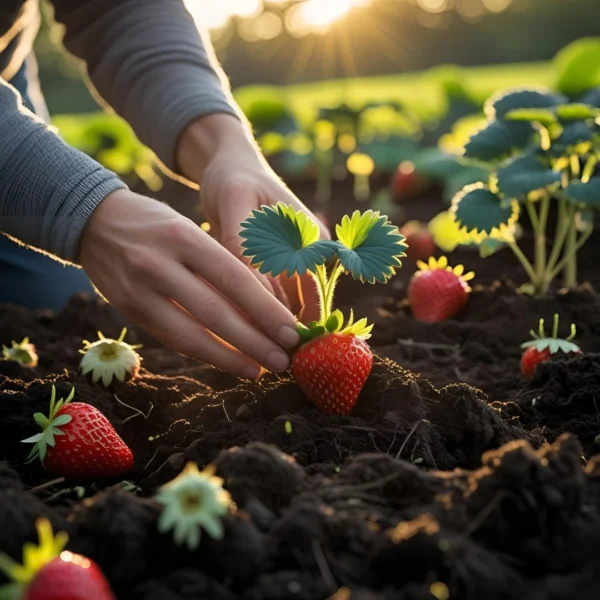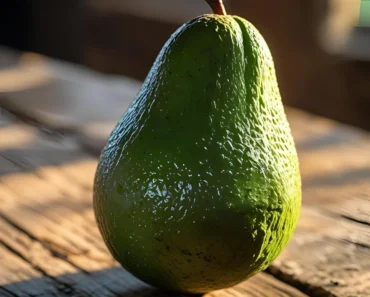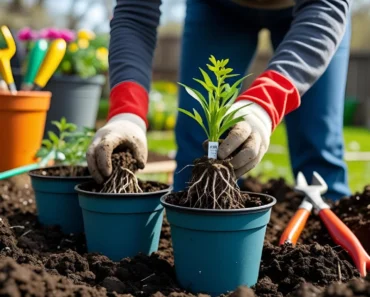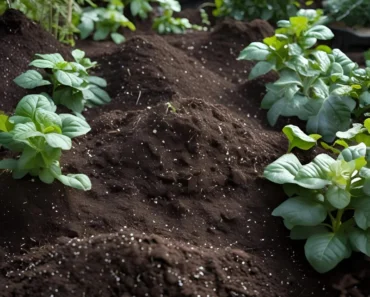Planting bare-root strawberries is a rewarding way to start or expand a strawberry patch. Bare-root plants arrive dormant, carefully packaged without soil, with exposed roots ready to establish in the garden. With the right preparation, planting technique, and care, these strawberries can flourish and produce abundant fruit for years. This comprehensive 1500-word guide details how to plant bare-root strawberries successfully, from soaking roots to aftercare best practices.strawberryplants+3

Why Choose Bare-Root Strawberries?
Bare-root strawberries are economical and lightweight for shipping. They arrive during dormancy, often in late winter or early spring, which aligns perfectly with optimal planting times. Bare-root plants encourage strong root development when planted properly and offer more selection than potted transplants.rogersgardens+1
Supplies and Preparation
Before planting, gather:
-
Bare-root strawberry plants
-
Well-draining garden soil or raised bed with amended soil
-
Compost or organic matter (3 inches ideal)
-
Garden trowel or small spade
-
Clean water for soaking and watering
-
Mulch such as straw, pine needles, or shredded bark
Step 1: Soak the Roots
As soon as you receive bare-root strawberries, gently untangle the roots and soak them in lukewarm water for about 30 to 60 minutes. Avoid soaking the crown (the swollen stem area between roots and leaves) as excess moisture there can cause rot. This rehydrates the roots and jumpstarts growth, encouraging healthy establishment once planted.gardenersdream+1
Step 2: Choose and Prepare the Planting Site
Strawberries require:
-
Full sun (at least 6 hours daily) for best fruiting
-
Well-draining soil to avoid root rot; sandy loam or raised beds are excellent
-
Soil amended with 3 inches of compost incorporated into the top 6 inches to supply nutrients and improve texture
-
Neutral to slightly acidic pH (5.5–6.5) ideal for nutrient uptake
Clear the area of weeds and debris beforehand. Avoid planting where tomatoes, potatoes, peppers, or eggplants grew recently to reduce disease risk.gardenbetty+2
Step 3: Dig the Holes with Proper Depth and Spacing
Strawberry roots can be long (up to 12 inches), but don’t dig excessively deep holes. Aim to dig holes just deep and wide enough to comfortably accommodate the roots without bending them.
To prevent J-rooting—where roots curl upward instead of growing down—dig a narrow, deep hole, or create a small mound of soil in the center so roots spread downward naturally.
Spacing depends on strawberry type:
-
Day-neutral varieties: 8 to 10 inches apart
-
Everbearers: 10 to 12 inches apart
-
Junebearers: 12 to 18 inches apart
Crowding plants can lead to poor air circulation and disease.strawberryplants+2
Step 4: Planting Your Bare-Root Strawberries
-
Position the Crown: The crown should sit right at soil level—neither buried nor exposed. Buried crowns are prone to rot, while exposed roots can dry out and become damaged.
-
Spread Roots: Gently fan out bare roots in the hole to mimic their natural spread.
-
Fill in Soil: Backfill around roots carefully, firming the soil lightly with your hands to remove air pockets.
-
Water Immediately: Water the newly planted area thoroughly to settle soil and hydrate the roots.
If soil settles later and roots become exposed, add a little more soil to cover them.ruralsprout+2
Step 5: Mulching
Apply a layer of mulch 2 to 3 inches thick around your plants, but keep mulch a few inches away from the crown to prevent rot.
Mulch helps:
-
Retain soil moisture
-
Regulate soil temperature
-
Suppress weeds
-
Protect fruits from contact with the soil, reducing rot
Common mulches include straw, pine needles, shredded bark, or black plastic mulch for weed control in commercial settings.gardenbetty+2
Step 6: Aftercare and Maintenance
-
Watering: Keep the soil consistently moist during establishment, especially during flowering and fruiting. Avoid overwatering which causes root rot.
-
Fertilizing: Incorporate compost at planting. Supplement with balanced organic fertilizers as growth resumes, but avoid heavy feeding at planting to encourage root development first.
-
Patience: New bare-root plants may take a few weeks to show leaf growth. Avoid disturbing roots by digging or excessive weeding nearby.
-
Pest Management: Monitor for slugs, birds, and strawberry pests. Use bird netting and organic deterrents as needed.
-
Runner Management: Depending on the variety and your goals, runners (stolons) can be removed to focus energy on fruit production or allowed to root to expand your patch.ruralsprout+2
Timing Your Planting
Bare-root strawberries are best planted in late winter to early spring, just as dormancy ends and before growth begins. This timing ensures plants utilize the full growing season to establish roots and produce fruit.
If frost is possible after planting, protect plants with frost cloth or mulch.
Advantages and Challenges of Bare-Root Strawberries
Advantages:
-
Cost-effective and lightweight for shipping
-
Strong healthy root systems develop
-
Greater variety selection
Challenges:
-
Requires prompt planting or proper storage (cool, moist)
-
Sensitive to improper planting depth (crown positioning)
-
More vulnerable to drying out or damage before establishment.rogersgardens+1
Troubleshooting Common Issues
-
Crown Buried: Causes rot and failure; gently lift plant if detected early.
-
Roots Exposed: Roots dry and die; add soil promptly.
-
Wilted Leaves Despite Water: Check soil drainage; roots may be rotted.
-
No Growth After Several Weeks: May indicate plant died or was planted too late.
Conclusion
Planting bare-root strawberries requires understanding root hydration, precise planting depth, site preparation, and attentive aftercare. By following these best practices, gardeners can establish productive, long-lasting strawberry patches that delight with fresh, flavorful berries.gardenersdream+4
- https://strawberryplants.org/guide-planting-bare-root-strawberry-plants/
- https://www.youtube.com/watch?v=IsoLRx_39bQ
- https://gardenbetty.com/bare-root-strawberries/
- https://www.rhs.org.uk/garden-inspiration/grow-your-own/plant-bare-root-strawberries
- https://www.gardenersdream.co.uk/blogs/gardeners-dream-blog/a-guide-to-bare-root-strawberries
- https://www.ruralsprout.com/bare-root-strawberries/
- https://www.rogersgardens.com/blogs/current-news-events/bare-root-plants-the-best-way-to-grow-your-own-garden-fresh-strawberries
- https://www.starkbros.com/growing-guide/how-to-grow/berry-plants/strawberry-plants/planting
- https://www.reddit.com/r/gardening/comments/17qmcf2/how_to_make_bareroot_strawberries/






